This Tiny Seaside Town on Grand Bahama Island Was Destroyed by a Hurricane — Here's What It's Like 4 Years Later
After Hurricane Dorian devastated Grand Bahama Island, here's how McLean's Town, on the eastern end of the island, is rebuilding.
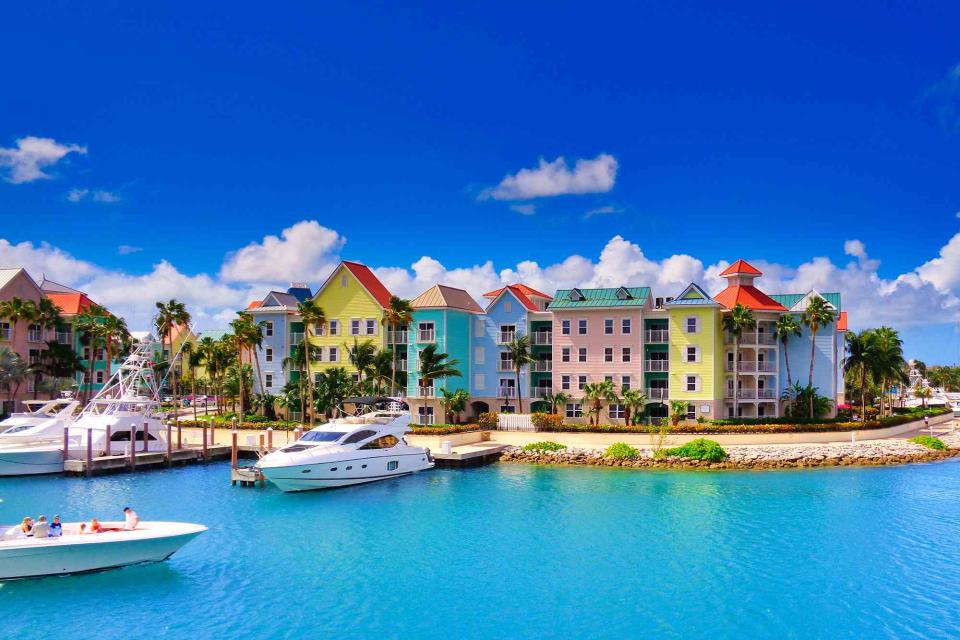
Henrik Landfors/Getty Images
Darkness crept over little McLean’s Town.
The winds howled, more powerfully than anyone could imagine. And then, somehow, got even stronger.
Waves of water, a massive sea surge, began rushing toward the defenseless two-street seaside village located on the far eastern end of Grand Bahama Island.
Hurricane Dorian had found its most vulnerable victim.
Near the height of the storm, Remelda Thomas, her husband, Phil, and their two youngest children, Dillard and Ebony, were all squeezed into a closet in their one-story home. It was the one place they felt any sense of shelter from the surging sea and 200 mph gusts. They had made it through hurricanes before. It seemed possible to make it through this one, too.
The water soon got too high in the closet, so the foursome climbed halfway up a ladder that led to the attic. Their roof had mostly been ripped off its underpinnings, so they couldn’t go all the way up. And they couldn’t go back down with water rushing in below. They were trapped.
So Mel and her family stayed as Dorian tossed cars into the nearby bay and drowned local vegetation so completely that, four years later, it still hasn't come back.
The town church was destroyed. The school was torn apart. The water level reached 19 feet in some places.
It wasn’t until more than 48 hours later, once Dorian had finally moved on, that the Thomas family exited what was left of their house. The street, and their town, were unrecognizable. But they had survived.
Mel’s first-born son, P.J., and his family, at the other end of McLean’s Town, were not so lucky. Their house was ripped off its foundation, leaving just tile floors as a reminder that there had once been a home there. P.J.’s wife, Baronette, survived, while P.J., 31, Mateo Bethel, 15, Phillip III, 8, and Remeille Thomas, 6, disappeared into the ocean. They were four of the five people killed by Dorian in McLean’s Town.
“We don’t know what life is gonna throw at us,” Mel told me, as I rode with her to McLean’s Town earlier this year. “You just don’t know. But when it comes, you have to handle it the best way you can.”
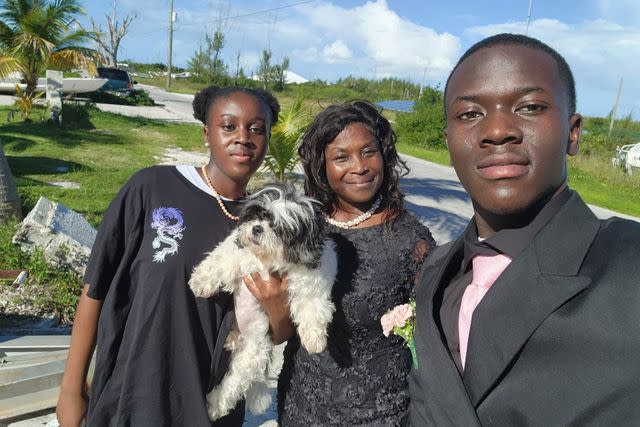
Courtesy of Remelda Thomas
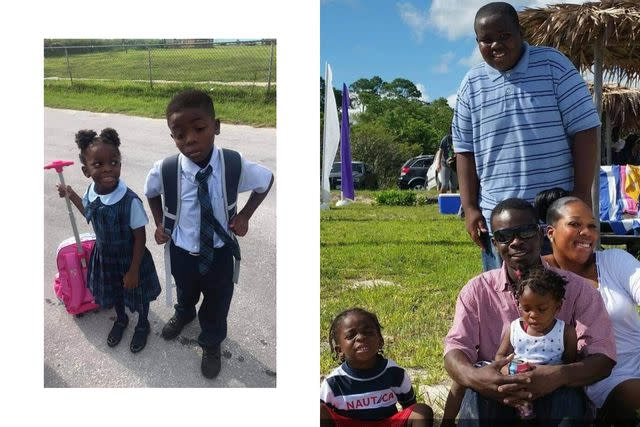
Courtesy of Remelda Thomas
Hurricane Dorian made landfall in The Abaco Islands, in the northern Bahamas, and then Grand Bahama Island — at full Category 5 strength in September 2019. It was one of the most powerful hurricanes to ever make its way across the Atlantic and is regarded as the worst natural disaster in Bahamas history. It hit the Bahamas' east end the hardest. More than 70 people on the islands were killed, with hundreds missing and presumed dead. Thousands were left without homes. The economy was shattered.
It would be easy to imagine that a place might never recover from a storm of such biblical proportions. But after traveling to the island about four years post-Dorian, I was relieved to see things looking nearly as beautiful and feeling as serene as they did 20 years ago when I first visited.
The thing about a close-knit community like McLean’s Town – and a small island like Grand Bahama – is that everyone knows each other. And after a calamity like Dorian, everyone is in it together.
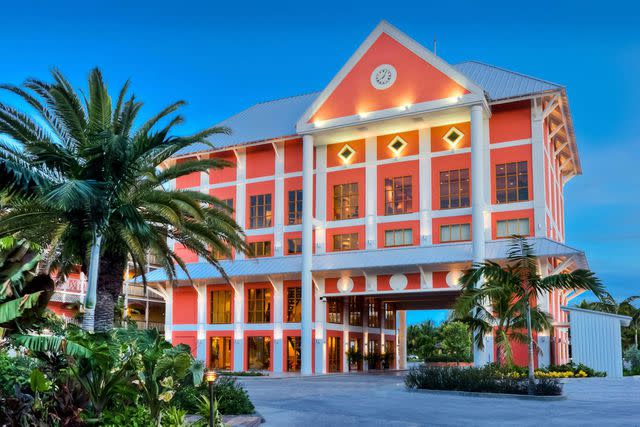
Courtesy of Pelican Bay
Take the Pelican Bay Hotel in Freeport, for example.
I spent my long weekend there. The 186-room hotel fronts the delightful Bell Channel Bay, ushering in a much-needed breeze on hot Bahama days. There are three restaurants, close access to bars, shopping in Port Lucaya Marketplace, and the uncrowded Taino Beach is just a five-minute ferry ride away.
I caught the sun rising over the bay while enjoying Pelican’s enormous breakfast buffet. I visited Bones Bar – a bonefishing-themed watering hole on property – at night for a drink or two.
Pelican Bay, of course, stepped up in a big way during Dorian and its aftermath. The hotel stayed open before, during, and right after the hurricane. It housed any employees who needed a place to stay and even gave free trips to its workers post-storm.
"Conditions on the island were not the best; many people had lost creature comforts, access to water, and even a warm bed to sleep in," said Magnus Alnebeck, Pelican Bay's general manager. "We wanted to help replace those things, even if just for a short time, to let them know we noticed their efforts and were thankful to them."
And Pelican Bay wasn't the only local business reaching out to victims of the storm.
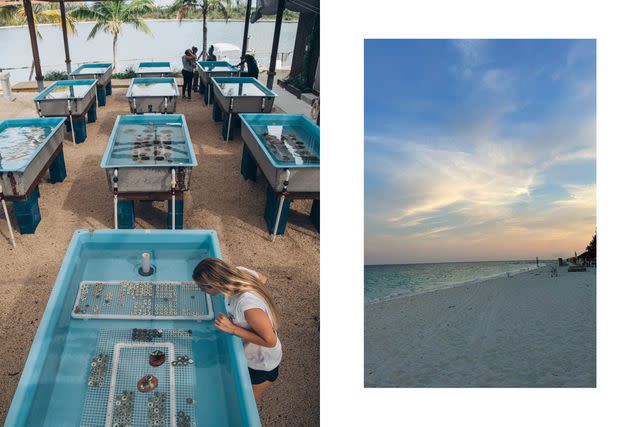
Coral Vita; Matthew Monagan/Travel+Leisure
Coral Vita provided another helpful hand.
The Freeport-based operation, winners of the venerated Earthshot prize, grows coral on a land-based farm. Once it’s mature enough, the coral is placed back in the ocean on reefs that have been damaged by storms, boats, and climate change. Using a process called micro-fragmentation, the scientists and activists at Coral Vita are able to grow coral at 50 times the rate it might grow in the wild.
“We have 30 tanks here, we eventually want to have 300,” Sam Reicher, Coral Vita's co-founder, told me. “In this plot of land, we have the potential to expand. Eventually, we also want to have farms like this in every country around the world."
Reicher’s team opened for business only weeks before Hurricane Dorian hit. Some of their tanks were found 30 to 40 miles away. Even so, Coral Vita’s truck was one of the first vehicles to get over to the east end of Grand Bahama to help McLean’s Town.
“We basically spent weeks doing rescue, relief work, and rebuilding,” Reicher said. He's hoping Coral Vita can help restore some of the reefs ripped apart by Dorian.
Stronger, healthier reefs, along with mangrove forests (Coral Vita also had a mangrove farm on property), can protect seaside towns and hotels from storms and huge waves – slowing down surges before they get too far. This is exactly what Reicher wants to teach tourists and locals, eventually having visitors reform reefs themselves.
For every remnant of Dorian’s destruction across Grand Bahama’s 530 square miles, there is a sign of strength and revitalization to match it.
The Garden of the Groves, a botanical garden that was ravaged by the hurricane, is back to looking like its lush old self. Old favorite The Stoned Crab restaurant stood strong after the storm. The service, the delicious seafood, and the Gully Wash (think: tropical White Russian) all remain on point.

Sylvain Sonnet/Getty Images
Back in McLean’s Town, the pace of recovery is slower and often more painful.
You can see it on the trees, stripped bare by Dorian, leading toward the easternmost end of the island. I could hear it in Remelda Thomas’s voice as we made our way around the neighborhood, when she took me to what’s left of her son P.J.’s house, and when she told me of the tragedies she's endured since. Mel lost her second-eldest son, Peter, in 2017. He went out in a boat to nearby Morse Island and never returned. In 2021, she lost her husband, Phil, after a battle with COVID-19.
“Yeah, it’s been tough, you know,” she looked at me. “But you cannot give up.”
And she, like her town, and her island, has not. Glimmers of hope, and strength, can be seen, even in battered McLean’s Town.
After a three-year hiatus, McLean's – known as the conch-cracking capital of the world, which it claims on a little sign at the entrance to town — brought back its annual conch-cracking festival at the end of 2022.
And bonefishing – long a major revenue source for the east end of the Bahamas – is at last beginning to surge back. Men and women, members of the devout bonefishing cult, are arriving, looking to catch the uncatchable.
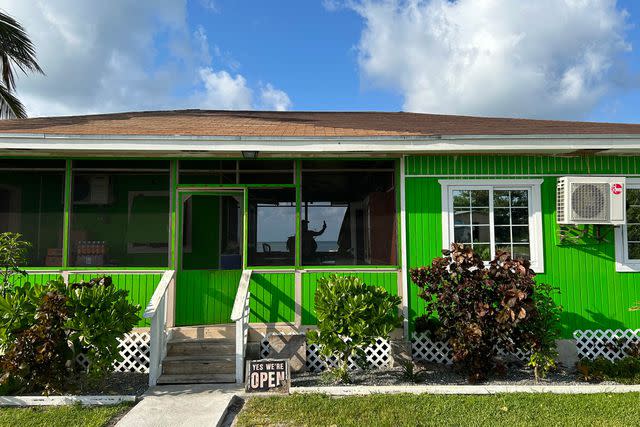
Matthew Monagan/Travel+Leisure
I could see the attraction of the sport after going out on the water with Captain Joe Thomas, a part-time pastor who’s been crisscrossing the pristine waters for the elusive fish since he was a toddler. There’s a peacefulness, a quiet that came as we motored away from land and anchored up to a spot to begin the hunt. Lemon sharks darted back and forth in the shallow waters looking for the same thing we were after. Joe, in almost a whisper (as if the fish might hear him), pointed off to the left side.
“Cast right there.”
It took time and effort (and some expert guidance from Captain Joe), but I finally reeled one in after a few hours. My teacher kissed it and threw it back into the sea.
As we trawled the shallow waters, he talked about the fish, the gorgeous cays surrounding us, the storm, and his town’s resilience, as any pastor would.
“Bahamians, we’re a strong people,” the captain said, motioning proudly toward the new roof recently placed atop his church.
Mel, a school administrator who moved (along with her school) to Freeport post-storm, helped run a bonefishing tour with her husband for decades. Phil was a legendary bonefish guide, and Captain Phil and Mel’s was one of the more popular outfits on all of Grand Bahama. Her son P.J., who was lost in the storm, took after his dad and was well on his way to running the family business.
Now, Mel runs it on her own.
She has help from the community – a town so small everyone is like family – and she hopes the only two children she has left, now in college in the U.S., will help grow the business someday. Once she retires from her government job, in a few years, she wants to go head-on into the bonefishing world.
She’d like to turn her own house – only partially wrecked by the storm – into a full-fledged lodge. She’d set up transportation from Freeport to McLean’s Town - buses traveling from the airport to spend two to three nights at “Captain Phil and Mel’s Bonefishing Lodge.”
It's a dream her family always had — and one she still has.
Who could ever doubt her, or these islanders, from making it happen?
For more Travel & Leisure news, make sure to sign up for our newsletter!
Read the original article on Travel & Leisure.

